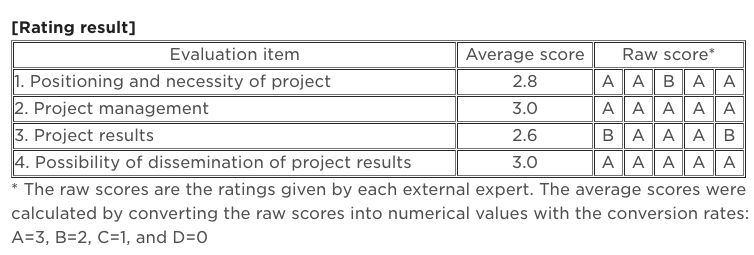Energy-Storage.news reported on the project back in 2017, which sought to show how the technology can reliable help the grid integrate renewables and improve flexibility, and the research has shown high long-term operating rates and capacity retention rates.
The ex-post evaluation by external experts was concluded in December 2022 with a results presentation and tour of the site in February earlier this year (viewable on Youtube), but Sumitomo only announced the completion publicly last week (7 July).
The external experts gave high marks on the four evaluation items with “many positive comments”, Sumitomo said, outlined in the table below. Much of the comments and research relates to the suitability of the technology for use in Japan.

“The knowledge obtained through this demonstration project will be particularly useful in forming an electricity market in Japan and creating a system for its operation, and it will serve as a basis for promoting and achieving decarbonisation in Japan,” said one expert comment.
“Technically, it is extremely significant that the storage battery system showed a high operating rate (99% in the final year of the project) and durability (a capacity retention rate of 90% or more for 20-years) in the actual electricity market.”
The project was part-funded by Japan’s New Energy and Industrial Technology Development Organization (NEDO) and the California Governor’s Office of Business and Economic Development (GO-Biz).
Pacific Northwest National Laboratory (PNNL) finds vanadium-alternative in ‘record-breaking experiment’
Sumitomo’s technology uses vanadium as an electrolyte, as most redox flow battery companies do.
However, US national lab PNNL said this week that it found a common food and medicine additive alternative that can “…boost the capacity and longevity of a next-generation flow battery design in a record-setting experiment”. The study was published in journal Joule.
The lab said the flow battery project maintained its capacity to store and release energy for more than a year of continuous charge and discharge, using a simple sugar derivative called β-cyclodextrin. Use of the derivative of starch boost the battery’s longevity and capacity.
The scientists optimised the ratio of chemicals in the system until it achieved 60% more peak power.
Then, they cycled the battery continuously for over a year, only stopping the experiment when the plastic tubing failed. During this time, the flow battery “barely lost any of its activity to recharge”.
PNNL claimed it is the first laboratory-scale flow battery experiment to report minimal loss of capacity after a year of continuous use.
"flow" - Google News
July 13, 2023 at 04:55PM
https://ift.tt/EqCgHF3
Flow battery technology milestones from PNNL and Sumitomo Electric - Energy-Storage.news
"flow" - Google News
https://ift.tt/ronCZ34
https://ift.tt/QRh2iVJ
Bagikan Berita Ini














0 Response to "Flow battery technology milestones from PNNL and Sumitomo Electric - Energy-Storage.news"
Post a Comment